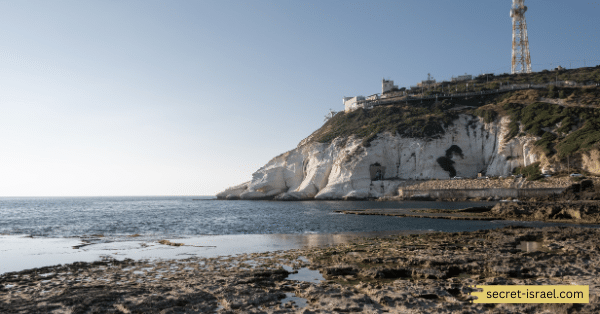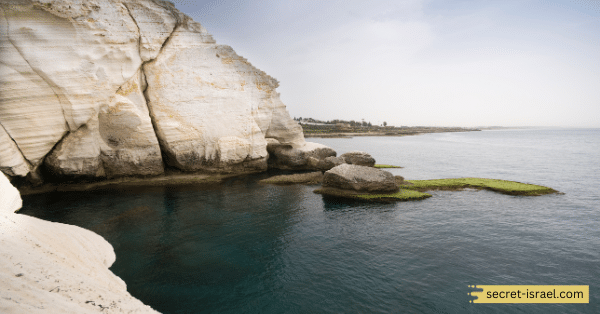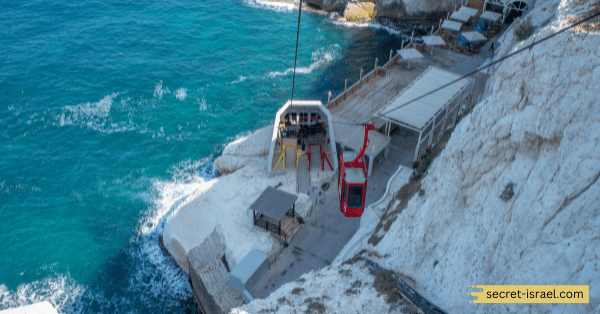Explore the breathtaking natural wonder of the Rosh Hanikra Grottoes with our comprehensive tourist guide. Discover the history, geology, and must-see attractions of this unique destination. Here, visitors can witness an awe-inspiring limestone sea cliff with amazing grottos carved into the rock.
Enjoy spectacular views of the Mediterranean Sea and explore this site’s unique geological formation, fascinating history, and plethora of activities. Read on for our comprehensive guide to Rosh Hanikra Grottoes – and get ready to explore one of the world’s most amazing sites!
Overview of the Rosh Hanikra Grottoes
The Rosh Hanikra Grottoes are a unique geological formation located on the Mediterranean coast of Israel, near the border with Lebanon. The grottoes are a series of caves and tunnels carved into the white limestone cliffs by the action of the sea over thousands of years.
Visitors can take a cable car or walk down to the grottoes and explore the caves on foot, where they can see stunning stalactites and stalagmites. The grottoes also offer breathtaking views of the Mediterranean Sea and the surrounding landscape. The Rosh Hanikra Grottoes are a popular tourist destination and a must-see for anyone visiting the area.

History and Geology of the Grottoes
The Rosh Hanikra Grottoes have a rich history and geology. The grottoes were formed over millions of years as the Mediterranean Sea pounded against the white limestone cliffs, carving out the caves and tunnels we see today. The grottoes have been known to mankind for thousands of years, with evidence of human habitation dating back to ancient times.
In more recent history, the grottoes were used as a strategic location during various conflicts, including the 1948 Arab-Israeli War and the 2006 Lebanon War. The grottoes were also used as a railway tunnel during the British Mandate period in Palestine.
Geologically, the Rosh Hanikra Grottoes are an excellent example of marine erosion, with the caves and tunnels being formed by the action of waves and the sea. The grottoes are made of white limestone, which is a type of rock that is easily dissolved by water. This process of dissolution creates unique and intricate shapes found in the grottoes, such as stalactites and stalagmites. The grottoes also have a unique feature called “curtains,” which are thin layers of rock that hang from the ceiling like curtains.
In summary, the Rosh Hanikra Grottoes are a unique and important destination for those interested in history, geology, and natural beauty. The grottoes are a result of millions of years of erosion and have played a role in human history for thousands of years.

Accessing the Grottoes: Transportation and Tickets
Accessing the Rosh Hanikra Grottoes is relatively easy, and there are several transportation options available for visitors.
By car: The grottoes are located on the Mediterranean coast, and can be easily accessed by car via the Rosh Hanikra Road. There is a parking lot available for visitors.
By train: The grottoes can also be accessed by taking a train to the nearby Rosh Hanikra station. From there, it is a short walk to the grottoes.
By bus: Several bus routes stop at Rosh Hanikra, which is the nearest bus stop to the grottoes.
Once you arrive, visitors can take a cable car or walk down to the grottoes. The cable car ride is a unique experience in itself, as it offers a bird’s eye view of the grottoes and the surrounding landscape.
Address: Israel
Opening Hours:
- Friday 9 AM–4 PM
- Saturday – Thursday 9 AM–6 PM
Phone: +972 73-271-0100
Admission Fee: ₪ 43.08
Navigate here to see the location’s actual view.

Activities and Attractions at the Rosh Hanikra Grottoes
The Rosh Hanikra Grottoes offer a wide range of activities and attractions for visitors to enjoy.
- Exploring the grottoes: Visitors can walk through the caves on foot and admire the stunning stalactites, stalagmites, and “curtains” that have been formed by the action of the sea over millions of years.
- Visiting the on-site museum: The museum provides information about the history and geology of the grottoes, and how they were formed.
- Taking a walk along the Mediterranean coast: Visitors can enjoy scenic views of the sea and the cliffs.
- Hiking: There are several hiking trails in the area, which offer panoramic views of the grottoes and the surrounding landscape.
- Rosh Hanikra light and sound show: An immersive experience that combines light and sound effects with the unique natural beauty of the grottoes, which takes place at nightfall.
- Water activities: Kayaking and boat trips along the coast are available for adventurous visitors.
- Cable car ride: Cable car offers a bird’s eye view of the grottoes and the surrounding landscape.
- Guided tours: Guided tours are an excellent way to learn about the history and geology of the grottoes and gain a deeper understanding of the natural wonder.
Tips for Visiting the Rosh Hanikra Grottoes
Visiting the Rosh Hanikra Grottoes can be a memorable experience, and here are some tips to make the most out of your visit:
- Plan your visit: Check the official website for information on opening hours, ticket prices, and other important details.
- Wear comfortable shoes: The grottoes can be slippery and uneven, and comfortable shoes are a must for exploring the caves on foot.
- Bring a flashlight: Although the grottoes are well-lit, a flashlight can come in handy for exploring some of the darker areas of the caves.
- Take a guided tour: Guided tours are an excellent way to learn about the history and geology of the grottoes and gain a deeper understanding of the natural wonder.
- Visit at different times of the day: The grottoes look different depending on the time of the day and visiting in the morning, afternoon, and evening can provide a different perspective and experience.
- Don’t forget your camera: The Rosh Hanikra Grottoes offer stunning natural beauty and incredible photo opportunities.
- Be aware of the weather conditions: The grottoes can be slippery and dangerous during rainy or wet conditions, so check the weather forecast and plan accordingly.
- Be prepared to walk: The grottoes are located at the bottom of the cliffs, and you need to walk down to reach them, so be prepared to walk.
In conclusion
The Rosh Hanikra Grottoes in Israel are a breathtaking natural wonder that offers visitors an unparalleled experience. The grottoes have been carved over millions of years by the action of seawater and feature unique geological formations such as stalactites and stalagmites. The grottoes also have a rich history and have been used for strategic purposes during various conflicts.
To make the most out of your visit, plan and be prepared to walk down to the grottoes. With its stunning natural beauty, rich history, and a multitude of activities available, the Rosh Hanikra Grottoes is a must-see destination for anyone visiting Israel.











